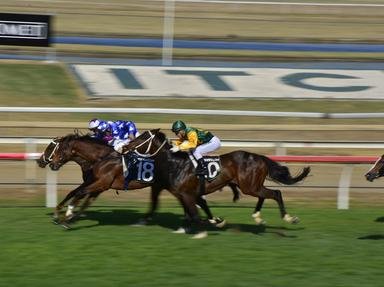Quiz Answer Key and Fun Facts
1. What type of horse race is the Melbourne Cup?
2. In which year was the Melbourne Cup first run?
3. Which organisation assumed responsibility for the running of the Melbourne Cup in 1864 and in subsequent years?
4. Which legendary Melbourne Cup winner was foaled by Night Raid, out of Entreaty?
5. Who said of the Melbourne Cup: "Nowhere in the world have I encountered a festival of people that has such a magnificent appeal to the whole nation. The Cup astonishes me."
6. Which 19th Century Cup winner's background included being stole by bushrangers?
7. Who was the first female trainer of a Melbourne Cup winner?
8. Which country is reflected in the name of the 1946 Cup winner?
9. In which year was Melbourne Cup Day declared a public holiday for those living in the Melbourne metropolitan area?
10. The 1925 Melbourne Cup has a special significance. Why?
11. The 1983 race saw Kiwi taste victory. What was remarkable about his performance?
12. Flemington Racecourse is familiar around the world as the venue for the Melbourne Cup. How was the name for the course chosen?
13. Which high profile performer was sensationally scratched only 39 minutes before the start of the 1969 race?
14. What was trainer of 1890 winner Carbine doing on the night following the race?
15. When was the photo finish camera first used to decide the placings in the Melbourne Cup?
16. Which was the first horse bred, owned, and trained in New Zealand to win the Melbourne Cup?
17. Which champion galloper was trodden on by Hyperno in the 1979 Cup, and later destroyed?
18. Which rider of two Melbourne Cup winners in the 1960s, was known as "The Professor"?
19. Which imported horse was the first to win the Cup?
20. Which lightweight mount overcame more popular runners to win the 1972 Cup?
21. On two occasions, in 1870 and 1916, rain caused the Melbourne Cup to be postponed. For a time it seemed a similar fate awaited the 1976 event. However, the weather cleared sufficiently to allow a start. Which proven "mudlark" led the field home?
22. What is the name of the trophy awarded to the strapper of the winning horse in the Melbourne Cup?
23. Between 1929 and 1935, a horse had six starts in the Melbourne Cup and finished no further back in the field than sixth. His record included four consecutive minor placings. What was the name of this luckless bay gelding?
24. Which trainer prepared the most Melbourne Cup winners?
25. Prior to the 1993 Melbourne Cup, the Irish entry Vintage Crop started in how many lead-up races?
Source: Author
shady_shaker
This quiz was reviewed by FunTrivia editor
Nightmare before going online.
Any errors found in FunTrivia content are routinely corrected through our feedback system.

